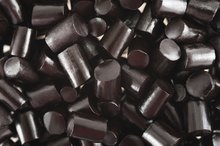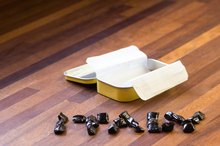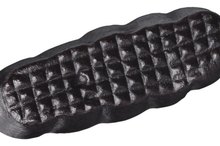Ingredients of Black Licorice
Black licorice candy is chewy and has a semi-firm consistency. It is flavored with licorice root extract that comes from the licorice plant. American licorice is a native, perennial legume that grows in temperate climates of North America, according to the United States Department of Agriculture. Licorice, which also grows in Europe and Asia, is the root of varieties of the Glycyrrhiza plant. The sweet flavor from Glycyrrhizin, a Greek word that means “sweet root,” has been extracted and used since ancient times for candy, teas, lozenges and medicines.
Sweeteners
Different brands of licorice use different sweeteners in addition to the sweet licorice extract. The most natural black licorice candy adds only molasses as a sweetener; some organic licorice candies contain organic sugar, organic molasses and corn syrup. Other sweeteners used in licorice recipes include glucose syrups and dextrose. According to research scientist, Perry Romanowski, in an article on the How Products Are Made website, sweeteners comprise about 60 percent of the licorice paste that is eventually formed into black licorice sticks and other shaped candy.
- Different brands of licorice use different sweeteners in addition to the sweet licorice extract.
- The most natural black licorice candy adds only molasses as a sweetener; some organic licorice candies contain organic sugar, organic molasses and corn syrup.
Flour
Nutritional Facts for Twizzlers Black Licorice
Learn More
Some licorice manufacturers use wheat flour to bind together all the ingredients in licorice. Wheat flour is composed of starch and protein. When it is combined with water, it creates gluten, a malleable paste that won’t break when it is stretched and rolled. Because of the wheat flour, licorice paste can be extruded into a variety of shapes and sizes. Some manufacturers have found ways to create wheat- and gluten-free black licorice. One way to do this is to use organic rice flour and organic rice starch.
- Some licorice manufacturers use wheat flour to bind together all the ingredients in licorice.
Soy Lecithin
Soy lecithin is used as an emulsifier to keep ingredients together in licorice products.
Flavoring
Kikkoman Soy Sauce Ingredients
Learn More
To give black licorice candy its unique flavor, licorice extract, anise and aniseed oils are included. Liquid caramel may also be used for flavoring. Salt is another ingredient in black licorice.
Coloring
Black licorice extract, caramel coloring and cocoa powder are used to give licorice its dark black color.
Oils
Sunflower oil and coconut oil are used by some licorice makers.
Minerals
Salty licorice, also called salmiakki, is a variety of black licorice made with ammonium chloride combined with the usual ingredients, according to The Food Museum Online Exhibit. Salty licorice is popular in Sweden, Finland, Norway, Denmark, the Netherlands and Northern Germany. Despite its high concentration of sugar, licorice is still susceptible to microbial contamination, which is why potassium sorbate is used as a preservative for some licorice recipes.
Other
The shiny surface of some black licorice candy comes from beeswax and carnauba wax. Gelatin and gum Arabic are used as binders and for texture. Because gelatin is made from animal keratin, vegetarians and vegans do not eat products made with it, but gum Arabic is derived from plants and has no animal products.
Related Articles
References
- USDA Plant Fact Sheet: American Licorice
- How Products Are Made: Licorice
- Nahidi F, Zare E, Mojab F, Alavi-Majd H. Effects of licorice on relief and recurrence of menopausal hot flashes. Iranian Journal of Pharmaceutical Research: IJPR. 2012;11(2):541-8.
- Irani M, Sarmadi M, Bernard F, Ebrahimi Pour GH, Shaker Bazarnov H. Leaves antimicrobial activity of Glycyrrhiza glabra L. Iranian Journal of Pharmaceutical Research: IJPR. 2010;9(4):425-8.
- NIH National Center for Complementary and Integrative Health. Licorice root. Updated December 1, 2016.
- Raveendra KR, Jayachandra, Srinivasa V, et al. An extract of glycyrrhiza glabra (GutGard)alleviates symptoms of functional dyspepsia: a randomized, double-blind, placebo-controlled study. Evidence-Based Complementary and Alternative Medicine. 2012;2012:1-9. doi:10.1155/2012/216970
- Messier C, Epifano F, Genovese S, Grenier D. Licorice and its potential beneficial effects in common oro-dental diseases. Oral Dis. 2012;18(1):32-39. doi:10.1111/j.1601-0825.2011.01842.x
- Shi Q, Hou Y, Yang Y, Bai G. Protective effects of glycyrrhizin against β2-adrenergic receptor agonist-induced receptor internalization and cell apoptosis. Biol. Pharm. Bull. 2011;34(5):609-617. doi:10.1248/bpb.34.609
- Tsao S, Yin M. Antioxidative and antiinflammatory activities of asiatic acid, glycyrrhizic Acid, and oleanolic acid in human bronchial epithelial cells. J. Agric. Food Chem. 2015;63(12):3196-3204.
- Zhao H, Zhang X, Chen X, et al. Isoliquiritigenin, a flavonoid from licorice, blocks M2 macrophage polarization in colitis-associated tumorigenesis through downregulating PGE2 and IL-6. Toxicology and Applied Pharmacology. 2014;279(3):311-321. doi:10.1016/j.taap.2014.07.001
- Nahidi F, Zare E, Mojab F, Alavi-Majd H. Effects of licorice on relief and recurrence of menopausal hot flashes. Iranian Journal of Pharmaceutical Research: IJPR. 2012;11(2):541-8.
- Hajiaghamohammadi AA, Zargar A, Oveisi S, Samimi R, Reisian S. To evaluate of the effect of adding licorice to the standard treatment regimen of helicobacter pylori. The Brazilian Journal of Infectious Diseases. 2016;20(6):534-538. doi: 10.1016/j.bjid.2016.07.015
- Irani M, Sarmadi M, Bernard F, Ebrahimi Pour GH, Shaker Bazarnov H. Leaves antimicrobial activity of Glycyrrhiza glabra L. Iranian Journal of Pharmaceutical Research: IJPR. 2010;9(4):425-8.
- Penn State Hershey Milton S. Hershey Medical Center. Licorice.
- Omar HR, Komarova I, El-Ghonemi M, et al. Licorice abuse: time to send a warning message. Therapeutic Advances in Endocrinology. 2012;3(4):125-138. doi:10.1177/2042018812454322
- Räikkönen K, Martikainen S, Pesonen A, et al. Maternal licorice consumption during pregnancy and pubertal, cognitive, and psychiatric outcomes in children. Am J Epidemiol. 2017;185(5):317-328. doi:10.1093/aje/kww172
- Consumer Reports. Food and drug interactions you need to know about. Updated November 4, 2018.
- Winchester Hospital. Library. Updated April 11, 2011.
- Consumer Reports. How to choose supplements wisely. Updated October 30, 2019.
- FDA. Black licorice: Trick or treat? Updated November 6, 2017.
Writer Bio
Maura Wolf's published online articles focus on women, children, parenting, non-traditional families, companion animals and mental health. A licensed psychotherapist since 2000, Wolf counsels individuals struggling with depression, anxiety, body image, parenting, aging and LGBTQ issues. Wolf has two Master of Arts degrees: in English, from San Francisco State University and in clinical psychology, from New College.









